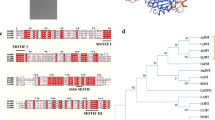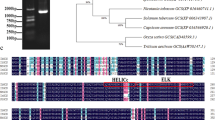Abstract
Saponins are important group of secondary metabolites known for their pharmacological properties. Chlorophytum borivilianum contains high amount of saponins and is thus, recognized as an important medicinal plant with aphrodisiac properties. Though the plant is well known for its pharmaceutical properties, there is meager information available about the genes and enzymes responsible for biosynthesis of saponins from this plant. Squalene synthase (SqS) is the key enzyme of saponin biosynthesis pathway and here, we report cloning and characterization of SqS gene from C. borivilianum. A full-length CbSqS cDNA consisting of 1,760 bp was cloned which contained an open reading frame (ORF) of 1,233 bp, encoding a protein of 411 amino acids. Analysis of deduced amino acid sequence of CbSqS predicted the presence of conserved isoprenoid family domain and catalytic sites. Phylogenetic analysis revealed that CbSqS is closer to Glycine max and monocotyledonous plants. 3D structure prediction using various programs showed CbSqS structure to be similar to SqS from other species. C-terminus truncated recombinant squalene synthase (TruncCbSqS) was expressed in E. coli M15 cells with optimum expression induced with 1 mM IPTG at 37 °C. The gene expression level was analyzed through semi-quantitative RT-PCR and was found to be higher in leaves as compared to the roots.







Similar content being viewed by others
References
Jat, R. D., Bordia, P. C. (1990). Propagation studies in safed musli (Chlorophytum species). In B. L. Chaudhary, N. C. Aery, & S. S. Katewa (Eds.), Proceedings of the national symposium on advances in plant sciences: current status and emerging challenges (p. 46). Udaipur: Department of Botany, M. L. Sukhadia University.
Thakur, M., & Dixit, V. K. (2006). Effect of Chlorophytum borivilianum on androgenic and sexual behavior of male rats. Indian Drugs, 43(4), 300–306.
Kumar, M., Meena, P., Verma, S., Kumar, M., & Kumar, A. (2010). Anti-tumour, anti-mutagenic and chemomodulatory potential of Chlorophytum borivilianum. Asian Pacific Journal of Cancer Prevention, 11, 327–334.
Govindrajan, R., Sreevidya, N., Vijaykumar, M., Thakum, M., & Dixit, V. K. (2005). In-vitro antioxidant activity of ethanolic extract of Chlorophytum borivilianum. Natural Products Science, 11, 165–169.
Deore, S. L., & Khadabadi, S. S. (2008). Anti-inflammatory and antioxidant activity of Chlorophytum borivilianum root extracts. Asian Journal of Chemistry, 20, 983–986.
Deore, S. L., & Khadabadi, S. S. (2010). Effect of Chlorophytum borivilianum on adjuvant induced arthritis in rats. Annals of Biological Research, 1(1), 36–40.
Tandon, M., & Shukla, Y. N. (1995). Phytoconstituents of Asparagus adescendens, Chlorophytum arundincaeum and Curculigo orichoides: a review. CROMAP, 12, 202–204.
Acharya, D., Mitaine-Offer, A. C., & Kaushik, N. (2009). Cytotoxic spirostane-type saponins from the roots of Chlorophytum borivilianum. Journal of Natural Products, 72, 177–181.
Abe, I., Rohmer, M., & Prestwich, G. D. (1993). Enzymatic cyclization of squalene and oxidosqualene to sterols and triterpenes. Chemical Reviews, 93(6), 2189–2206.
Takatsuji, H., Nishino, T., Izui, K., & Katsuki, H. (1982). Formation of dehydrosqualene catalyzed by squalene synthetase in S. cerevisiae. Journal of Biochemistry, 91, 911–921.
Wentzinger, L., Bach, T., & Hartmann, M. (2002). Inhibition of squalene synthase and squalene epoxidase in tobacco cells triggers an up-regulation of 3-hydroxy-3-methylglutaryl coenzyme A reductase. Plant Physiology, 130(1), 334–346.
Akamine, S., Nakamori, K., Chechetka, S. A., Banba, M., Umehara, Y., Kouchi, H., et al. (2003). cDNA cloning, mRNAexpression, and mutational analysis of the squalene synthase gene of Lotus japonicus. Biochimica et Biophysica Acta, 1626(1–3), 97–101.
Hata, S., Sanmiya, K., Kouchi, H., Matsuoka, M., Yamamoto, N., & Izuki, K. (1997). cDNA cloning of squalene synthase genes from mono and dicotylednous plants, and expression of the gene in rice. Plant and Cell Physiology, 38, 1409–1413.
Hayashi, H., Hirota, A., Hiraoka, N., & Ikeshiro, Y. (1999). Molecular cloning and characterization of two cDNAs for Glycyrrhiza glabra squalene synthase. Biological &/and Pharmaceutical Bulletin, 22, 947–950.
Lee, J. H., et al. (2002). Cloning and expression of squalene synthase cDNA from hot pepper (Capsicum annuum L.). Molecules and Cells, 13, 436–443.
Lee, M. H., Jeong, J. H., Seo, J. W., Shin, C. G., & Kim, Y. S. (2004). Enhanced triterpene and phytosterol biosynthesis in Panax ginseng overexpressing squalene synthase gene. Plant and Cell Physiology, 45, 976–984.
Seo, J. W., Jeong, J. H., Shin, C. G., Lo, S. C., Han, S. S., & Yu, K. W. (2005). Overexpression of squalene synthase in Eleutherococcus senticosus increases phytosterol and triterpene accumulation. Phytochemistry, 66, 869–877.
Kim, D. T., Han, Y. J., Huh, H. G., & Choi, E. Y. (2001). Expression and functional characterization of three squalene synthase genes associated with saponin biosynthesis in Panax ginseng. Plant and Cell Physiology, 52(1), 125–137.
Sunil, K., Shikha, K., Sanjay, K., Jagdeep, K., & Kashmir, S. (2012). Differentially expressed transcripts from leaf and root tissue of Chlorophytum borivilianum: A plant with high medicinal value. Gene, 511, 79–87. doi:10.1016/j.gene.2012.09.046.
Ghawana, S., et al. (2011). An RNA isolation system for plant tissues rich in secondary metabolites. BMC Research Notes, 4, 85.
Kribii, R., et al. (1997). Cloning and characterization of the Arabidopsis thaliana SQS1 gene encoding squalene synthase—involvement of the C-terminal region of the enzyme in the channeling of squalene through the sterol pathway. European Journal of Biochemistry, 249, 61–69.
Gasteiger, E., Hoogland, C., Gattiker, A., Duvaud, S., Wilkins, M. R., & Appel, R. D. (2005). Protein identification and analysis tools on the ExPASy server. In J. M. Walker (Ed.), The proteomics protocols handbook (pp. 571–607). Totowa: Humana Press.
Ashkenazy, H., Erez, E., Martz, E., Pupko, T., & Ben-Tal, N. (2010). ConSurf 2010: Calculating evolutionary conservation in sequence and structure of proteins and nucleic acids. Nucleic Acids Research, 38(Web Server Issue), 529–533.
Geourjon, C., & Deleage, G. (1995). SOPMA: significant improvement in protein secondary structure prediction by consensus prediction from multiple alignments. Computer Applications in the Biosciences, 11, 681–684.
Tamura, K., Dudley, J., Nei, M., & Kumar, S. (2007). MEGA4: Molecular evolutionary genetics analysis (MEGA) software version 4.0. Molecular Biology and Evolution, 24, 1596–1599.
Zhang, Y. (2008). I-TASSER server for protein 3D structure prediction. BMC Bioinformatics, 9, 40.
Bhat, W. W., et al. (2012). Molecular cloning, bacterial expression and promoter analysis of squalene synthase from Withania somnifera (L.) Dunal. Gene, 499, 25–36.
Singh, K., et al. (2004). 26S rRNA-based internal control gene primer pair for reverse transcription polymerase chain reaction-based quantitative expression studies in diverse plant species. Analytical Biochemistry, 335, 330–333.
Holden, M. T., et al. (2004). Complete genomes of two clinical Staphylococcus aureus strains: evidence for the rapid evolution of virulence and drug resistance. Proceedings of the National Academy of Sciences of the United States of America, 101, 9786–9791.
Kaneda, K., et al. (2001). An unusual isopentenyl diphosphate isomerase found in the mevalonate pathway gene cluster from Streptomyces sp. Strain CL190. PNAS, 98(3), 932–937.
Devarenne, T. P., Ghosh, A., & Chappell, J. (2002). Regulation of squalene synthase, a key enzyme of sterol biosynthesis, in tobacco. Plant Physiology, 129, 1096–1106.
Gu, P., Ishii, Y., Spencer, T. A., & Shechter, I. (1998). Function–structure studies and identification of three enzyme domains involved in the catalytic activity in rat hepatic squalene synthase. Biological Chemistry, 273, 12515–12525.
Pandit, J., et al. (2000). Crystal structure of human squalene synthase. A key enzyme in cholesterol biosynthesis. Journal of Biological Chemistry, 275, 30610–30617.
Lee, S., & Poulter, C. D. (2008). Cloning, solubilization, and characterization of squalene synthase from Thermosynechococcus elongatus BP-1. Journal of Bacteriology, 190, 3808–3816.
Robinson, G. W., Tsay, Y. H., Kienzle, B. K., Smithmonroy, C. A., & Bishop, R. W. (1993). Conservation between human and fungal squalene synthetases: Similarities in structure, function, and regulation. Molecular and Cellular Biology, 13, 2706–2717.
Ashby, M. N., & Edwards, P. A. (1990). Elucidation of the deficiency in two yeast coenzyme Q mutants. Characterization of the structural gene encoding hexaprenyl pyrophosphate synthetase. Journal of Biological Chemistry, 265(22), 13157–13164.
Nayar, M. P., Sastry, A. R. K. (1988). Chlorophytum borivilianum. In M. P. Nayar, & A. R. K. Sastry (Eds.), Red data book of Indian plants (Vol. 2) (p. 142). Calcutta: Botanical Survey of India.
Jinting, L., & Zhenghai, H. (2008). Accumulation and dynamic trends of triterpenoid saponins in vegetative organs of Achyranthus bidentata. Journal of Integrative Plant Biology, 764, 1744–1749.
Acknowledgments
The Authors are thankful to Council of Scientific and Industrial Research (CSIR), India, for providing the financial assistance (Scheme No. 38(1188)08/EMR-II) to carry out the research work. Authors are also grateful to Dr. Rahul Shubhra Mandal, Scientist—I, NICED, Kolkata for his help in analysis of 3D structure prediction.
Author information
Authors and Affiliations
Corresponding author
Electronic supplementary material
Below is the link to the electronic supplementary material.
Rights and permissions
About this article
Cite this article
Kalra, S., Kumar, S., Lakhanpal, N. et al. Characterization of Squalene synthase Gene from Chlorophytum borivilianum (Sant. and Fernand.). Mol Biotechnol 54, 944–953 (2013). https://doi.org/10.1007/s12033-012-9645-1
Published:
Issue Date:
DOI: https://doi.org/10.1007/s12033-012-9645-1




